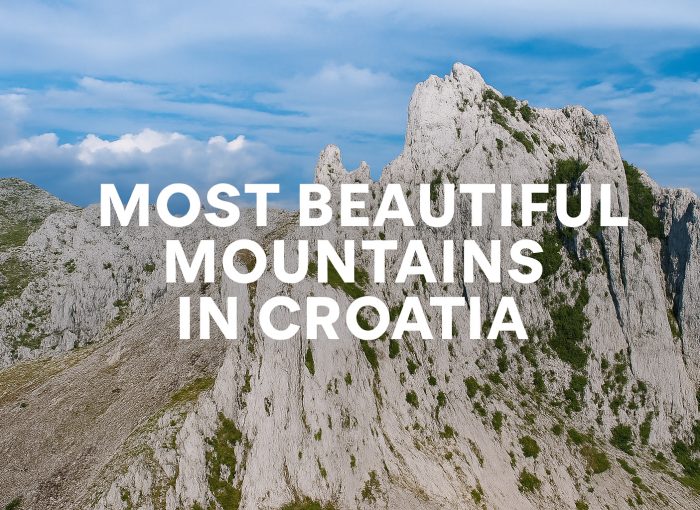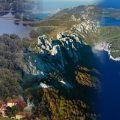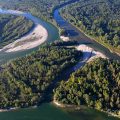Discover the most beautiful mountains in Croatia – from Tulove grede and Dinara to Biokovo and Risnjak. Wild nature, epic views, and karst wonders.
The most beautiful mountains in Croatia are not just high peaks – they are the wild heart of the country, sheltering rare species, offering breathtaking views and deep silence. Their beauty is shaped by the karst phenomenon, a unique geological world that over millions of years carved towers, ridges, sinkholes, and deep canyons. From the jagged cliffs of Velebit, and the raw Dinara to the forested Gorski kotar, Croatian mountains are a dream for hikers, photographers, and lovers of nature alike.
Bijele and Samarske Stijene (up to 1335 m)
In the heart of Gorski kotar, these rocky giants form a strict nature reserve – a labyrinth of vertical towers, narrow passages, and deep sinkholes shaped by karst erosion. Hiking here feels like stepping into a fairytale of stone.
Fun fact: Snow lingers in shaded crevices well into summer.
Hajdučki and Rožanski Kukovi (up to 1650 m)
These wild and inaccessible limestone formations in Northern Velebit form a stone maze unlike any other. Located within a strict nature reserve, entry is permitted only with special permission. This is the realm of bears, lynxes, and golden eagles.
Fun fact: This area hides Lukina jama, one of the world’s deepest caves!
Tulove Grede (1120 m)
These dramatic limestone spires rise sharply from the southern slopes of Velebit. The landscape is otherworldly – especially at sunset. Old Austro-Hungarian roads pass nearby, and this area was famously featured in the Winnetou movies.
Fun fact: A hotspot for endemic plants and butterflies.
Velika Paklenica Canyon
Not a typical peak, but one of the most spectacular mountain canyons in Croatia. With 700-meter-high cliffs and hidden waterfalls, it’s a climbers’ paradise and a must for hikers. Read more about Paklenica
Fun fact: It hides a massive Cold War bunker, now a museum!
Dinara (1831 m – highest peak in Croatia)
This rugged mountain marks the roof of Croatia. The climb to the peak Sinjal is demanding but rewarding, offering panoramic views of Dalmatian hinterland and Bosnia. Home to chamois and eagles, with rare alpine flora.
Fun fact: The entire Dinaric Alps are named after this very mountain.
Sveto Brdo (1751 m)
The second highest peak of Velebit, and perhaps the most spiritually inspiring. The view from the summit stretches over the islands, Ravni kotari, and on clear days, the Kornati archipelago.
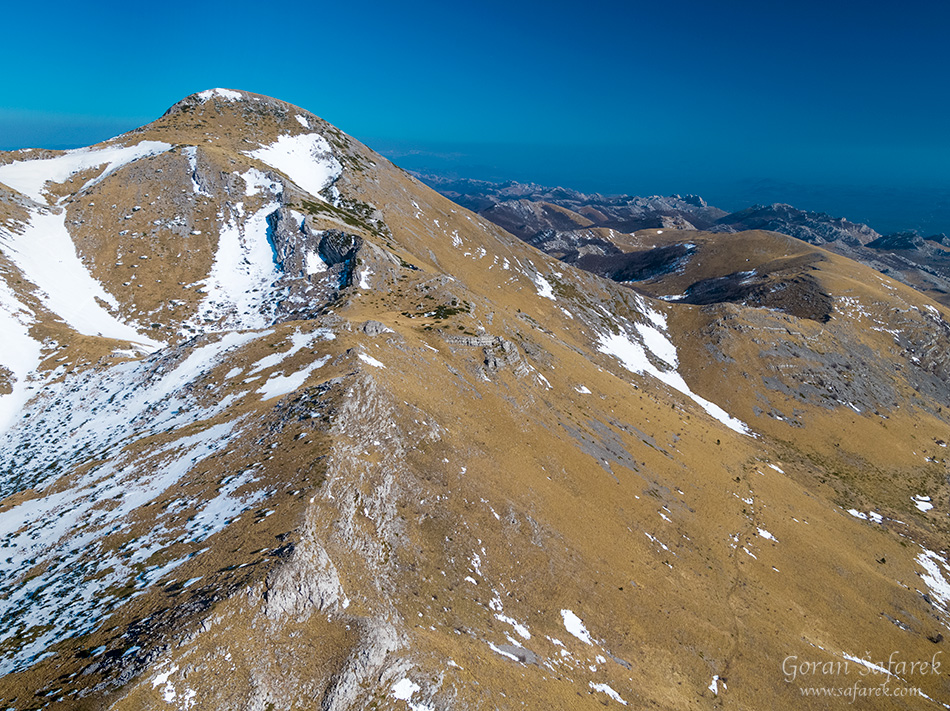
Fun fact: Often chosen for spiritual hikes and meditative climbs.
Zavižan (1594 m)
Easily accessible peak in Northern Velebit, home to Croatia’s highest weather station. From here, trails lead into Velebit Botanical Garden, showcasing the mountain’s rich flora.
Fun fact: Receives some of the heaviest snowfall in Croatia.
Štirovača (Northern Velebit)
A peaceful contrast to the harsh karst above – a valley full of spruce and beech forest, cold springs, and alpine meadows. A refreshing summer escape.

Fun fact: The landscape resembles a mini Scandinavia.
Risnjak (1528 m)
The heart of Risnjak National Park, this mountain is named after the elusive lynx (ris). The summit offers views over the Kvarner Bay, and the forests below are among the most diverse in Croatia.
Fun fact: Over 1000 plant species thrive here, including rare orchids.
Kalnik – Kalnički Zubi
Located in northern Croatia, these tooth-like limestone formations rise above the Kalnik Fortress. A favorite spot for climbers and weekend hikers alike.
Fun fact: Legend says locals defended King Béla IV here and earned noble status.
Sveti Ilija (Pelješac) (961 m)
The highest peak of Pelješac and the ultimate Adriatic viewpoint. From the summit you can see Korčula, Mljet, and even Italy on clear days!

Fun fact: Known for its strong winds and postcard-perfect panoramas.
Vela Draga (Učka)
Hidden on the western slopes of Učka, this karst canyon is filled with slender rock towers. It’s one of Croatia’s oldest climbing areas and a true natural sculpture garden.
Fun fact: The karst erosion here continues creating new towers over time.
Biokovo Cliffs and Karst
Biokovo’s limestone cliffs rise vertically above the Adriatic. Its upper slopes are carved by deep karst pits and ridges, while the summit – Sveti Jure (1762 m) – offers one of the most famous vistas in Croatia.
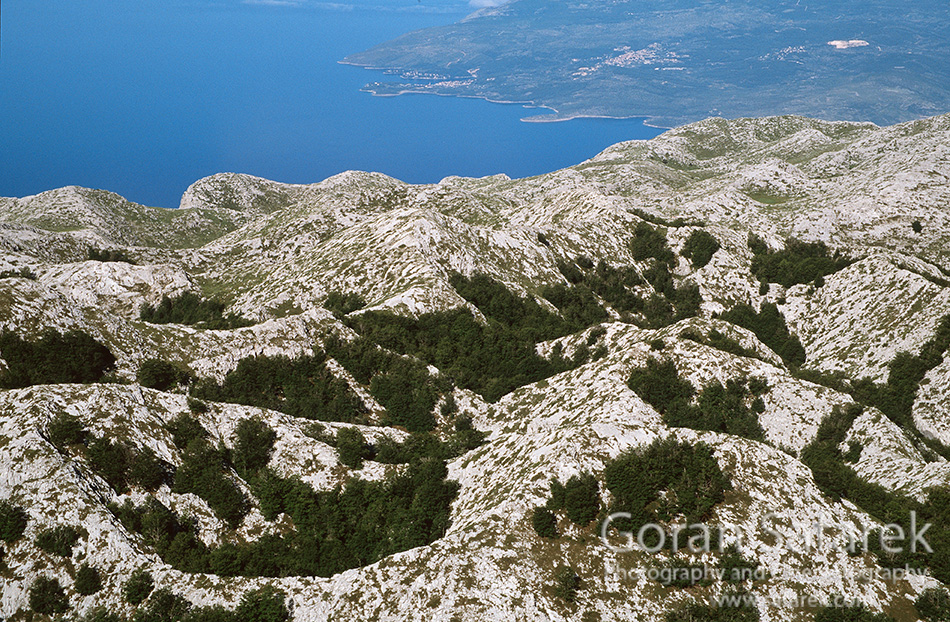
Fun fact: More than 400 caves and pits have been explored on Biokovo.
Samoborsko Gorje (Japetić 879 m)
A gentle, forested highland west of Zagreb, with open meadows and scenic viewpoints. The Japetić iron lookout tower offers vistas toward Slovenia and Žumberak.
Fun fact: A protected meadow below Japetić is home to wild mountain orchids.
Dabarski Kukovi (Central Velebit)
This dramatic chain of sharp limestone peaks cuts through the Dabarska plateau like a stone dragon’s back. They’re less known than their northern cousins, but equally stunning. Several well-marked trails connect the kukovi, leading hikers through epic views and deep solitude.
Fun fact: The name “kukovi” refers to the jagged rock ridges that define this spectacular landscape.
🌄 In Conclusion:
Croatian mountains are more than just heights and peaks – they are stories written in stone, views that take your breath away, and silence where nature speaks the loudest. From the karst ridges of Velebit, through the snowy forests of Risnjak, to the sun-drenched viewpoints of Biokovo and Pelješac – every step through these mountains brings us closer to something deeper: a feeling of freedom and connection with nature.
Whether you’re an experienced mountaineer or a weekend wanderer, these mountains are waiting for you – to be felt under your feet and in your heart.
